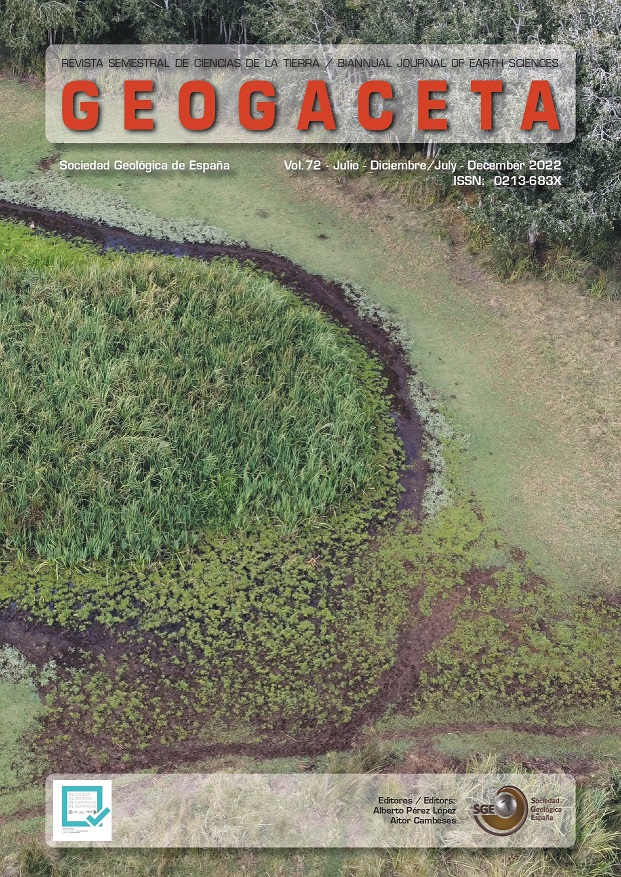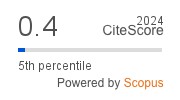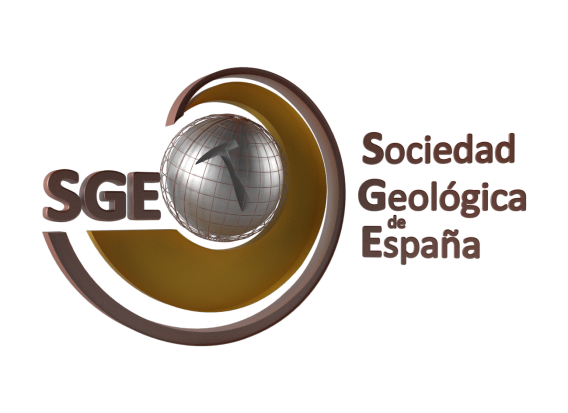Hidrogeología del sistema Kárstico de la Sierra de Hinodejo (Cordillera Ibérica, España)
DOI:
https://doi.org/10.55407/geogaceta98411Palabras clave:
hidrodinámica, recarga natural, evolución hidrogeológica, Cordillera Ibérica, sistema kársticoResumen
El sistema kárstico de la Sierra de Hinodejo se ha desarrollado a favor de un conjunto calcáreo del Cretácico Superior con geometría compartimentada en estrechos sinclinales ocupados por acuíferos, con una capacidad de reservas subterráneas de entre 1.85 y 2,41 hm3. La recarga en este acuífero libre de 41 km2 de extensión es principalmente autógena y difusa. El flujo subterráneo va dirigido por el fondo de los sinclinales hacia los manantiales de Villabuena (121 l/s) y surgencias efímeras de la hoz del río Izana en aguas altas. Todas ellas de régimen muy variable. Son importantes las transferencias subterráneas al Terciario y Cretácico calcáreo de la Cuenca de Almazán. La parte pleniplanizada del norte ha conservado en gran medida el funcionamiento hidrogeológico desde las primeras fases de la karstificación. La erosión y exhumación de cúpulas anticlinales cretácicos al sur durante el Cuaternario ha permitido la transferencia subterránea a manantiales efímeros asociados a importantes sistemas lagunares de cierre tobáceo.
Citas
Beltrán Cabrera, F.J., Ríos Mitchell, J.M., Ríos Aragüés, L.M. (1980). Mapa Geológico de España 1:50.000, hoja nº 349 (Cabrejas del Pinar) y Memoria. IGME, Madrid, 20 p.
Benito-Calvo, A., Pérez-González, A. (2007). Geomorphology 2007, 88, 226-241. https://doi.org/10.1016/j.geomorph.2006.11.005
Fonollá Veiga, Cristina. (2021). Paleohidrogeología del sistema kárstico del manantial de Fuentetoba. (Cordillera Ibérica, Soria). Tesis Doctoral. Universidad Politécnica de Madrid.
Guilbot, A. (1975). Modélisation des Écoulements d'un Aquifère Karstique (Liaison Pluie-Débit). Application Aux Bassins de Saugras et du Lez. Ph.D. Thesis, Université des Sciences et Techniques du Languedoc, Montpellier, France, 1975.
Hernanz, A. (1979). Curso de Hidrología General y Aplicada. Escuela de Hidrología; Centro de Estudios Hidrográficos: Madrid, Spain, p. 29.
IGME (Instituto Geológico y Minero de España) 1991. Hoja Geológica 1/50.000 nº 378 (Quintana Redonda).
Pérez, J., Sanz, E. (2010). Environ. Earth Sci, 1, 20-30.
Rodríguez-García, J.A. (2008). Ph.D. Geomorfología de un Sector de la Cuenca de Almazán (Soria): Procesos de Erosión de Suelos y Planteamiento de Escenarios Ante el Cambio Climático. Thesis, Univ. Complutense de Madrid, Madrid, Spain, p. 390.
Rosas, P., Sanz, E, Menéndez-Pidal, I. (2016). Estud. Geológicos, 72, e047. https://doi.org/10.3989/egeol.42132.375
Sanz, E. (1992). En: III Congreso Geológico de España y I Congreso Iberoamericano de Geología. Salamanca, Spain Comunicaciones Tomo 3., pp. 91-95. Available online: https://soporte.dialnet.unirioja.es/portal/es/kb/articles/acceso-adocumentos-a-texto-completo (accessed on 23 June 2021).
Sanz Pérez, E.; Fonolla, C., Menéndez Pidal, I., Rosas Rodriguez, (2021). Sustainability, 13, 7236. https://doi.org/10.3390/su13137236
Press, Cambridge, 292-299. Valverde Hernández, M.F. (1989). Mapa Geológico de España 1:50.000, hoja nº 378 (Quintana Redonda) y Memoria. IGME, Madrid, 42 p.
Descargas
Publicado
Cómo citar
Número
Sección
Licencia
Hasta el año 2023 el autor/a cedía el copyright (“derechos de autor”) a la Sociedad Geológica de España, pero desde el 2024 el/la autor/a conserva los derechos de autor y concede a la Sociedad Geológica de España el derecho de la primera publicación y de manera no exclusiva cede la distribución de cada artículo en todos los soportes actuales o futuros, al mismo tiempo que ceden, también de manera no exclusiva, los derechos comerciales para la distribución de la versión impresa de Geogaceta. Por otra parte, los artículos, a partir del año 2023, están disponibles simultáneamente a su publicación, bajo la licencia Creative Commons CC BY-NC-SA 4.0, que permite copiar, transformar el trabajo, pero si se distribuye transformándolo, el nuevo trabajo debe distribuirse bajo la misma licencia, y nunca con propósitos comerciales, al tiempo que se reconoce la autoría y la publicación original en GEOGACETA, de tal manera que el único rol del copyright es dar a los autores el control sobre la integridad de sus trabajos y el derecho de ser adecuadamente reconocidos y citados.









